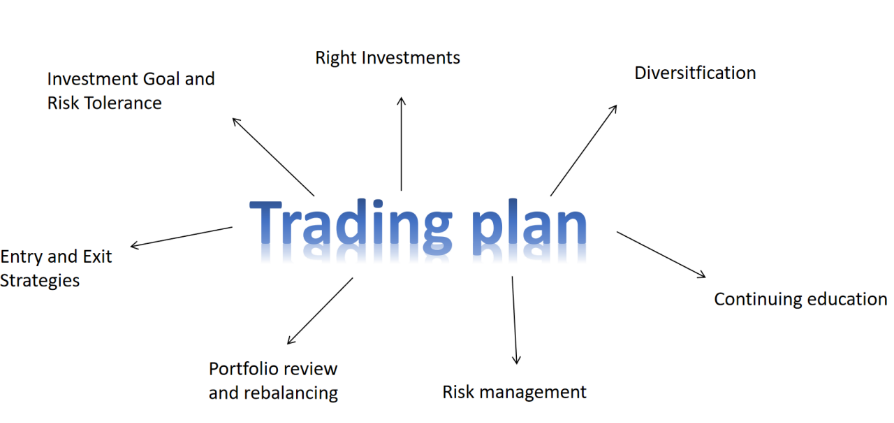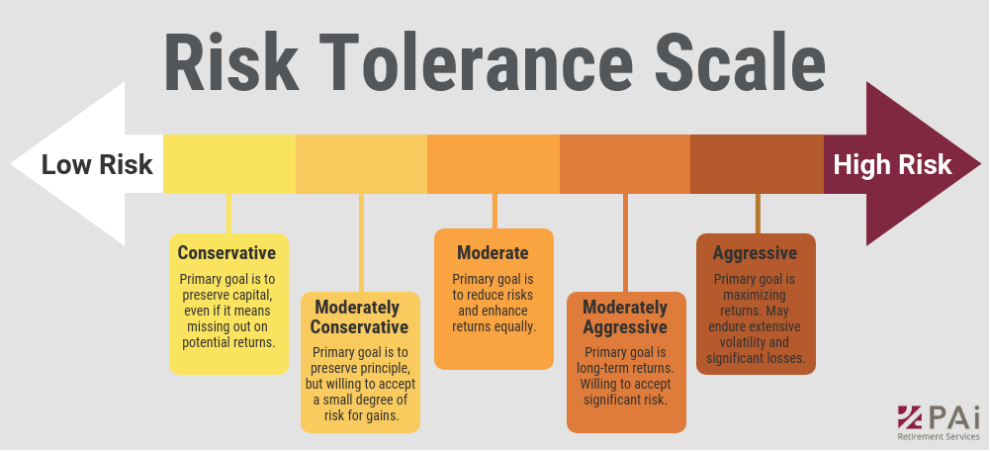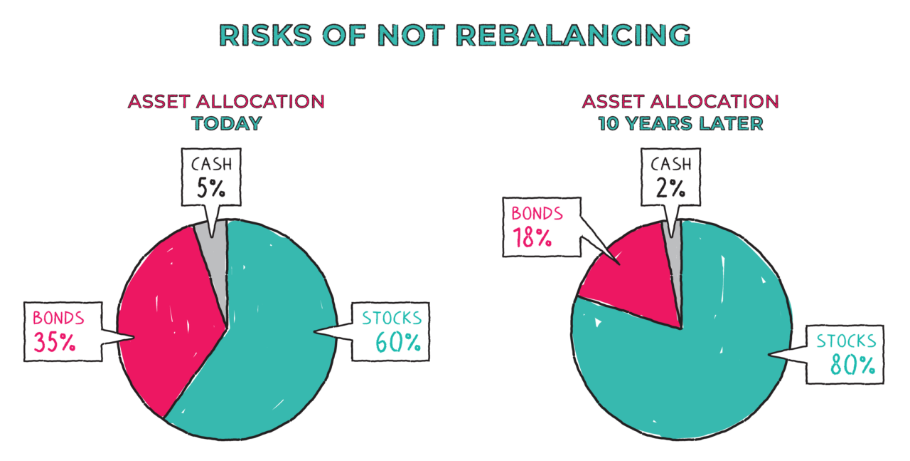स्टॉक और ईटीएफ निवेश और पोर्टफोलियो प्रबंधन के लिए एक ट्रेडिंग योजना बनाना
मुख्य शिक्षण उद्देश्य:
परिचय: This section takes you through the creation of a sound trading plan tailored for stock and ETF investments. By embracing diversification and learning effective risk management strategies, you set the stage for a balanced and successful investment journey.
- Master the Basics of a Trading Plan: Delve deep into the intricacies of crafting a robust trading plan tailored for stock and ETF investments. By understanding its pivotal nature, you’ll be better prepared to weather market storms and capitalize on opportunities.
- Diversify and Thrive: Learn why putting all your eggs in one basket is rarely a good idea in the world of investing. Grasping the essence of विविधता will allow you to minimize risks and optimize returns, ensuring a balanced investment journey.
- Strategies for Risk Management: Get acquainted with effective risk management tools and practices. With this knowledge, you’ll be better prepared to safeguard your investments against unforeseen market downturns, ensuring peace of mind.

आकृति: The infographic emphasizes the importance of making the right investments. It highlights various components of a successful investment strategy, including setting an investment goal, diversifying investments, understanding risk tolerance, having a clear trading plan with entry and exit strategies, continuous education, regular portfolio reviews and rebalancing, and effective risk management.
स्रोत: कस्टम इन्फोग्राफिक
परिचय
Creating a trading plan is a fundamental step toward successful investing. It’s like a roadmap that guides your investment decisions, helping you stay focused and disciplined, even during market turbulence. In this chapter, we’ll explore how to create a comprehensive trading plan for investing in stocks and ETFs and managing your portfolio effectively.
18.1 Understand Your Investment Goals and Risk Tolerance
Your investment goals and risk tolerance should be the foundation of your trading plan. Are you investing for long-term wealth accumulation, or are you more focused on short-term gains? How much risk are you willing to take on? Understanding your objectives and risk tolerance helps you choose the right investment strategy that aligns with your financial goals and comfort level.

आकृति: The infographic emphasizes the importance of avoiding overactivity in stock trading. It suggests checking in on your stocks once per quarter, such as when you receive quarterly reports. The graphic also highlights the challenge of not constantly monitoring stock performance, indicating the emotional aspect of investing.
स्रोत: कस्टम इन्फोग्राफिक

Figure title: Risk Tolerance Scale & Portfolio Types
स्रोत: PAI
विवरण: The figure illustrates a risk tolerance scale, transitioning from low risk on the left to high risk on the right. Along this scale, five distinct portfolio types are mapped, showing their respective risk levels. These portfolios range from conservative, implying the least risk, to aggressive, suggesting the highest level of risk.
चाबी छीनना:
- Portfolio Risk Levels: The scale indicates five portfolios—conservative, moderate conservative, moderate, moderate aggressive, and aggressive. Their positions on the scale denote the inherent risk they carry.
- Guidance for Investors: The visual representation aids investors in associating specific portfolios with their respective risk appetites.
आवेदन: The scale is instrumental in guiding investors to choose portfolios that align with their risk tolerance. Understanding where a specific portfolio lies on the risk spectrum ensures that investors can make choices that resonate with their financial goals and comfort levels.
18.2 Choosing the Right Investments: Stocks and ETFs
Once you’ve established your goals and risk tolerance, the next step is to choose the right investments. Stocks allow you to own a piece of a company and potentially benefit from its growth and success. ETFs, on the other hand, give you exposure to a diversified portfolio of assets, reducing the risk associated with individual stocks. Your decision should be based on your investment goals, risk tolerance, time horizon, and market knowledge.
18.3 Diversification
Diversification is an essential component of any trading plan. It involves spreading your investments across various assets to minimize risk. In the context of stocks and ETFs, this could mean investing across different sectors, geographies, or asset classes. The goal is to build a portfolio that can withstand market volatility and reduce potential losses.
18.4 Entry and Exit Strategies
Define clear entry and exit strategies for each investment. An entry strategy could be based on specific market conditions, financial indicators, or price levels. Similarly, an exit strategy could be a predetermined price target or stop-loss level to protect your investments from significant losses.

आकृति: This infographic emphasizes the importance of patience and strategy in investing. It highlights the concept of building positions gradually and underscores that time, rather than timing, is an investor’s superpower. The message is clear: successful investors buy stocks with an expectation of long-term rewards, not short-term gains.
स्रोत: कस्टम इन्फोग्राफिक
18.5 Regular Portfolio Review and Rebalancing:
Regularly review your portfolio to ensure it aligns with your investment goals and risk tolerance. Rebalance your portfolio as necessary to maintain your desired asset allocation. For example, if one of your stocks has performed exceptionally well and now makes up a larger percentage of your portfolio, you might consider selling some shares to maintain balance.

Figure title: Importance of Rebalancing in Maintaining Portfolio Allocation
स्रोत: नैपकिन वित्त
विवरण:
The figure presents a portfolio at two different times: today and ten years later. Initially, the portfolio is 5% cash, 35% bonds, and 60% stocks. Over a decade, this changes to 2% cash, 18% bonds, and 80% stocks due to varying asset performance.
चाबी छीनना:
- Asset Drift: Over time, the weightings of the portfolio’s assets can drift significantly from the original allocations.
- Risk Exposure: The shift towards 80% in stocks could increase the portfolio’s risk, straying from the investor’s original objectives.
- Rebalancing: This process helps realign the portfolio to its original or updated asset mix, ensuring it meets the investor’s risk and target goals.
आवेदन पत्र:
Rebalancing is essential to maintain your portfolio’s risk level and keep it aligned with your investment objectives. It helps you not only in mitigating risks but also in potentially capturing gains by selling high and buying low.
18.6 Risk Management
Risk management is crucial in any trading plan. This could involve setting stop-loss orders to limit potential losses, diversifying your investments, or only investing money you can afford to lose. Remember, the goal is not to eliminate risk but to manage it effectively.
18.7 Continuing Education
The financial markets are dynamic and constantly changing. It’s important to stay informed about market trends, new investment opportunities, and changes in the economic environment. This could involve reading financial news, attending investment seminars, or taking advanced investment courses.
चाबी छीनना:
बंद बयान: A well-structured trading plan is the backbone of successful investing. This section imparts the knowledge and strategies for crafting a robust trading plan, promoting a disciplined approach to managing risks and optimizing returns in your investment journey.
- At the heart of successful investing lies a well-structured trading plan. It provides a roadmap, helping investors remain level-headed during market turbulence and capitalizing on favorable conditions.
- विविधता is not just a buzzword; it’s a foundational strategy for risk mitigation. By spreading investments across various assets, one can cushion against sharp declines in any particular sector or stock.
- असरदार risk management isn’t about avoiding risks but managing them. With the right strategies, you can ensure that market downturns don’t derail your investment goals, allowing for more consistent growth.

